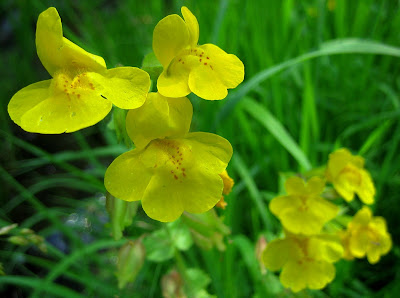So there we were, early in the frosty morning air, looking down a north-facing valley from the top of a mid-elevation, 8,000 foot ridge running from the Divide:

Dave has a GPS and actually knows how to use it (unlike someone that I am who also has one but doesn't...), and he had programmed a couple of waypoints along three likely looking branches of our target valley. Good thing, since both of us had forgotten just how thick the undergrowth could be on these c. 8,000 foot north-facing slopes. Bushwhacking through dense, wonderful stuff like Mountain alder (Alnus incana) that you need a machete to hack your way through. Note the male catkins and female fruits:

No Lost Dutchman mine, but like any hike in a new place, there were lots of things to see, including signs of the Anaconda Company operations that clearcut this area c. 1900 and sent the timber down a flume to feed the copper smelter. Today, it's a lovely, well-watered valley, with tremenous open parks and boggy areas. Looks like great elk habitat: several miles from the nearest road, rugged as hell, and good feeding & bedding areas. I've hunted all around this area, and might give this spot a walk come elk season, so long as I have friends (you're on the list, Dave) that like helping haul elk pieces out of such a place.
Summer wildflowers have taken over these mid-elevation slopes. In the drier areas, there are Common Harebells (Campanula rotundfolia):

Fireweed (Epilobium angustifolium):

Orange Mountain Dandelion (Agoseris aurantiaca):

Geraniums, both White (Geranium richardsonii):

And pink Sticky (Geranium viscossimum):

Tall Larkspur (Delphinium occidentala):

And lots of grouse food such as Grouse Whortleberry, Elderberry, and (here pictured) Red Twinberry (Lonicera utahensis):

In the wetter areas, there were some trophy (six to eight foot tall) Cow Parsnip (Heracleum lanatum):

And some of the really boggy areas had lots of delicate, beautiful White Bog Orchids (Habenaria dilata):

Close-up:

A lovely spring gushing from the mountain side was blanketed with Monkeyflower, dominated by the common pink variety Mimulus lewisii:

Close-up:

But accompanied by the somewhat uncommon Yellow Monkeyflower (Mimulus guttatus):

Like most people, I'm attracted to "the fairist among them all." But even the humblest posses their own charm, such as this Western Groundsel (Senecio integerrimus):

If I hunt this high, wet valley come elk season, I'll be lucky to notice the ridge features that will steer me back to the truck. Usually, elk hunting is a matter of keeping your nose to the ground, finding & following a big track, and stalking through the thick stuff in hopes of catching one napping. That's part of the rhythm of the season, and when it's time to hunt I try to be "fully present" (as the Zen Buddhists say) in that activity, getting into the seams of space/time. For now, it's summer hiking time.

2 comments:
Absolutely gorgeous wildflowers. I especially like the harebells which are quite rare here in southeastern Minnesota. Some of the others, of course, we don't have at all.
I just took a bunch of pictures of these yesterday, and instead of having to look up one plant individually, I can just look at your page. Wonderful!
Post a Comment